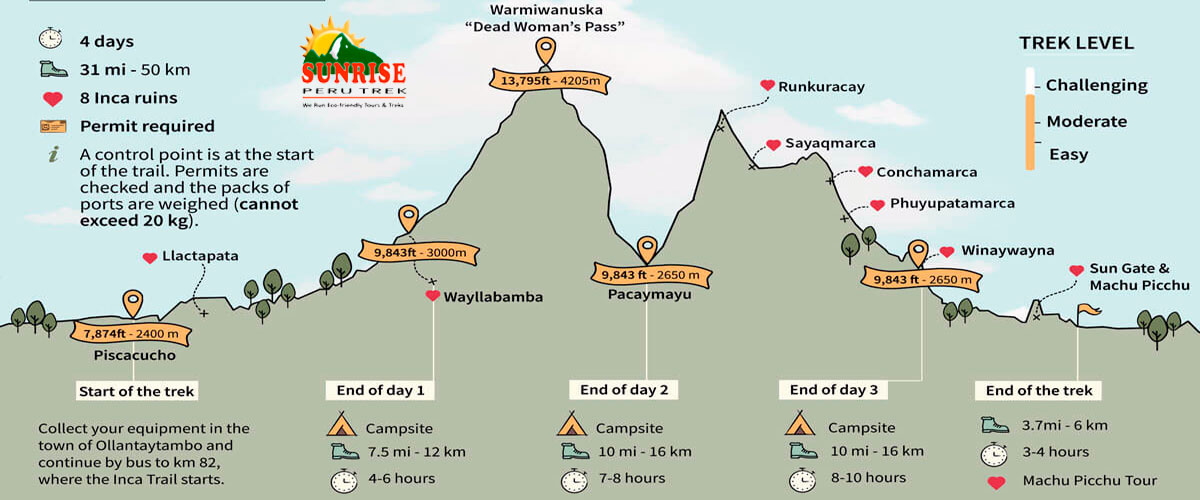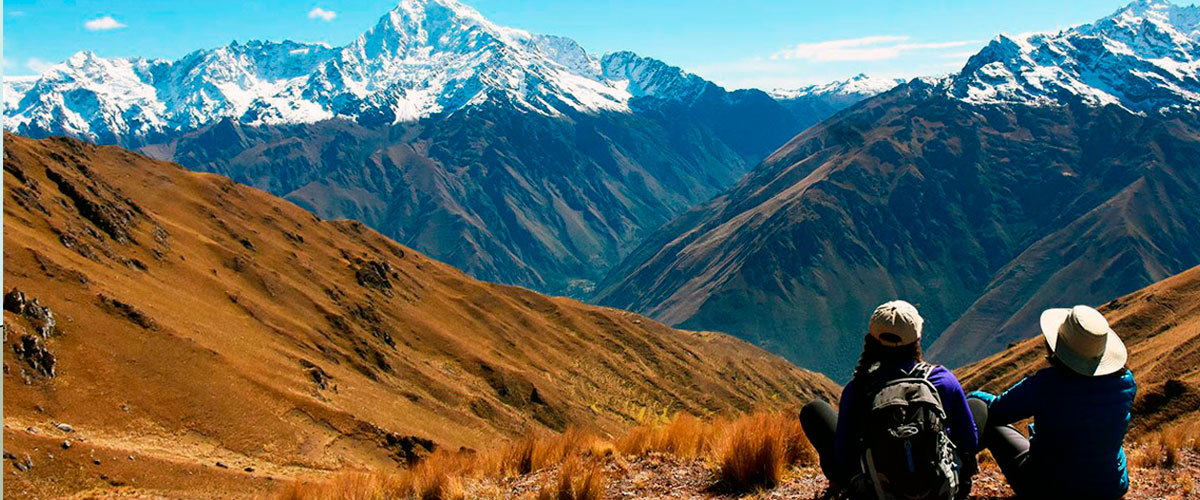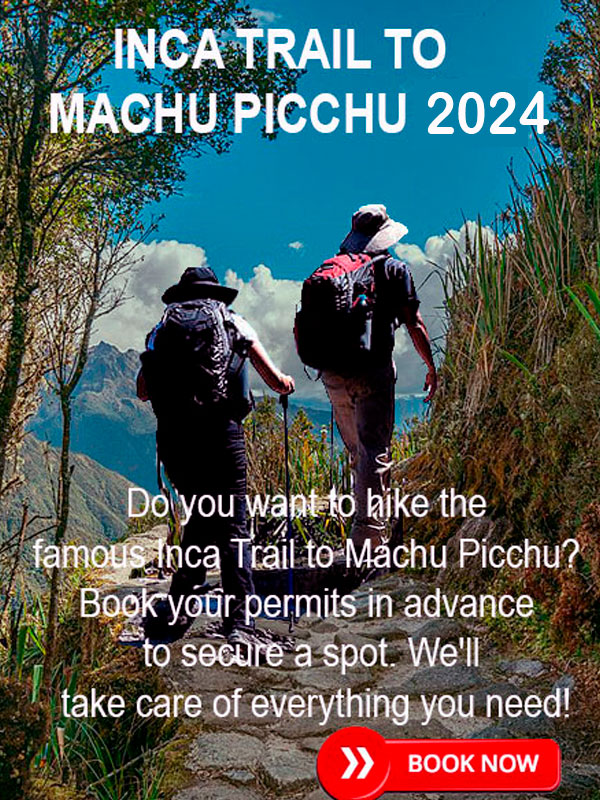Altitud for Inca Trail to Machu Picchu
Explore Machu Picchu on the Inca Trail, and experience breathtaking views at the highest point of 4,200 meters above sea level. Get ready to discover an unforgettable journey!

Exploring the Inca Trail’s Mesmerizing Altitude
The Inca Trail is an iconic trek that takes you through breathtaking landscapes, meandering paths, and stunning ancient ruins. But one of its defining features is its high altitude—soaring up to 4,200 meters in some places. Anybody who embarks on this incredible journey should be prepared for the altitude.
Altitude sickness is not something to be taken lightly, and many hikers find that their body takes a bit of time to adjust to the elevation. It’s important to take the necessary precautions before beginning your trek: hydrate well, rest at appropriate intervals, and hike slowly. If you experience any concerning symptoms such as dizziness or nausea, it’s best to stop and take a break.
On the Inca Trail, you’ll be rewarded with mesmerizing views of snow-capped mountains, terraced fields, and lush valleys. With an experienced guide by your side and adequate preparation in terms of altitude acclimation, you’re guaranteed to have the experience of a lifetime! From the moment you step foot onto the trail, you’ll be surrounded by history and nature—and nothing but pure magic.
What is the Altitude for Inca Trail to Machu Picchu? …Anyone can do it?
In the following lines you’ll find important information for the Inca Trail to Machu Picchu. At 2,400 meters above sea level is situated the lost city of Machu Picchu, and it is one of the lowest altitude points of the Inca Trail. The highest point is the “Abra Warmihuañusca” known as the “Dead Woman’s Pass”, which is surrounded by 4,200 meters above sea level. From where the views of the Andes are splendid.
Most of the treks to Machu Picchu start in in the city of Cusco, which is located at 3,400 meters above sea level; it is higher than Machu Picchu. Being here for at less two days before trekking to Machu Picchu helps with your acclimatization and with the climatic conditions of the Inca Trail.
The altitude of the Inca Trail to Machu Picchu varies considerably; it is subject to the type of program that you’ll chose and the quantity of day that you’ll desire to walk.
The Classic Inca Trail begins at a place called “Pisqhakuchu” known as the Km 82 at 2750 meters above sea level, descends slowly in the morning before suffering the delay in Yuncachimpa at 3300 meters above sea level. Although this is an altitude high enough to cause altitude sickness, if you’ve spent several days in Cusco beforehand, everything will be fine for now.
BOOK YOUR 4-DAYS INCA TRAIL TO MACHU PICCHU
The second day is the most difficult of the Inca Trail, because it takes place on the neck of the dead woman at 4,200 meters above sea level. It is essential that you feel the effect of altitude on sea level, as there is less oxygen supplied than you are used to. It doesn’t take long at this altitude and the rest of the day is spent going down to 3,600 meters above sea level; where you will camp in “ Pacaymayu” or continue to “Chaquicocha”; all depends your Inca Trail Permits.
From Pacaymayu the trail is long but beautiful with many photo opportunities until the last camp the normally is “Wiñayhuayna” at 2600 meters above sea level. From here the walk is easy to get at “Puerta del Sol” or the sun gate, then at Machu Picchu, where the Inca trail ends.

How does the altitude affect to hikers on the Inca Trail?
Hiking the Inca Trail to Machu Picchu is truly an incredible experience, but it’s also one that comes with its own set of challenges. One such challenge is dealing with altitude.
The Inca Trail lies at an elevation ranging from 8,000 to 13,800 feet (2,438 – 4,206 meters). This means that if you live in a place near sea level or lower elevations (like most people do), your body will have to adjust to thinner air and less oxygen when you reach higher altitudes. If you don’t take proper precautions, this can result in acute mountain sickness—also known as altitude sickness – which includes symptoms like headache, nausea/vomiting, tiredness/lack of energy and shortness of breath even when resting. To be safe while hiking the Inca Trail (and indeed any trekking route at high altitudes) it’s important for hikers to prepare for the effects of altitude by slowly acclimatizing and staying hydrated.
One-way hikers can begin preparing before they arrive in Peru is by spending time walking up hills or running on a stair-climber machine several weeks prior to their trip. That way they are already physically conditioned before hitting the trail which may help them better acclimatize during their hikes. Additionally taking several rest days during your journey allows your body time to adapt as well as giving yourself opportunity for leisure activities and exploration rather than tiring yourself out further trying keep going against the thinning airiness.
Once hikers have arrived in Peru, they should allow themselves 2–3 days for acclimation before beginning their hike on The Inca Trail since being exposed too quickly can cause issues with breathing difficulties due different levels oxygen pressure as well headaches dizziness fatigue difficulty sleeping; all common signs of Altitude Sickness. Furthermore, maintaining hydration throughout the journey either through oral consumption liquids some fruit flavored electrolytes powder sachets available drugstores help ensure sufficient fluid levels necessary sustain enough energy walk uphill longer trails preventing deadly dehydration conditions.
Similarly consuming fibers carbohydrates protein slows down absorption glucose bloodstream keeping steady blood sugar stable vital trekkers maintain adequate mileage every day. Finally carrying small bag coca leaves along handy remedy try chew spit out help fight off symptoms severity once experienced although not scientifically proven natural remedy used thousands of years native cultures South America supplement vitamin rich diet fruits vegetables nuts seeds grains fish oils preferably fresh caught items rice quinoa combination these approaches minimize risk Altitude Sickness maximize enjoyment journey creating unforgettable lifetime memories.
Brief Inca info for Trail Trail Altitude
Cusco – KM-82 – Wayllabamba
- Difficulty level: easy
- Maximum altitude: 3,000 m.
- Minimum altitude: 2,600 m.
- Distance traveled: 9 km
- Approximate walking time: 5-6 hours.
Wayllabamba – Paso Warmiwañusca – Paccaymayu
- Difficulty level: difficulty
- Maximum altitude: 4600 m.
- Minimum altitude: 3000 m.
- Distance traveled: 12 km
- Approximate walking time: 6-7 hours.
Paccaymayu – Runkuraqhay Pass – Phuyupatamarka – Wiñayhuayna
- Difficulty level: moderate.
- Maximum altitude: 4000 m.
- Minimum altitude: 2,650 m.
- Distance traveled: 16 km
- Approximate walking time: 8 hours.
Wiñayhuayna – Inti Punku (Puerta del Sol) – Machu Picchu – Aguas Calientes – Ollantaytambo – Cusco
- Difficulty level: easy
- Maximum altitude: 2,650 m.
- Minimum altitude: 2100 m.
- Distance traveled: 6 km
- Approximate walking time: 2 hours.
Acute Mountain Sickness – AMS
Also called acute altitude sickness, it means that the onset is sudden, it begins as something light, moderate and gradual, the symptoms are severe, just like if not treated, they worsen and can turn into an acute illness.
In general, for been affected by altitude sickness, it must be higher than 2,500 meters above sea level. Therefore, while Machu Picchu is below this point, the Dead Woman’s Pass is high enough to cause symptoms of altitude sickness.
The demand for muscles depends on the level of activity, but the brain needs a large amount of oxygen (15% of the total). If the brain lacks oxygen for the speed with which it was promoted and exerted a great effort, they will have the following symptoms:
- Hard to sleep.
- Vertigo
- tired
- headache
- Lack of appetite
- Nausea or vomiting.
- fast pulse
- Difficulty breathing
- Prevention
To anticipate AMS, we recommended:
- Climb the mountain gradually, rest and follow the guide’s instructions; sleep at a lower height and, above all, learn to identify the first symptoms of Altitud Mountain Sickness.
- See, with your doctor, there are medications that can help you with the Altitud while you are trekking.
- Drink plenty of fluids, avoid alcohol, eat foods rich in carbohydrates.
- Prevent and identify the MAS during the Inca Trail?
- Prepare your body and physical condition in advance. If possible, quit smoking.
- Remember to spend at least 2 days in a city at high altitude, before starting the Inca Trail Trek.
- Drink especially liquids (3 to 4 liters per day), especially water.
- Avoid taking sleeping pills.
- Eat small portions of food frequently, even if you don’t have an appetite, avoid excess salt.
You also can decide to hike the short Inca trail in two days see here more info:



